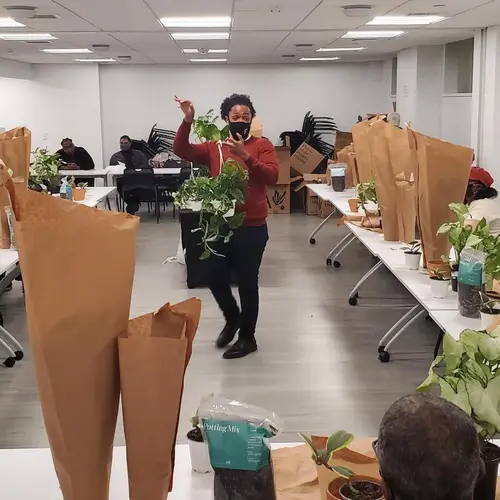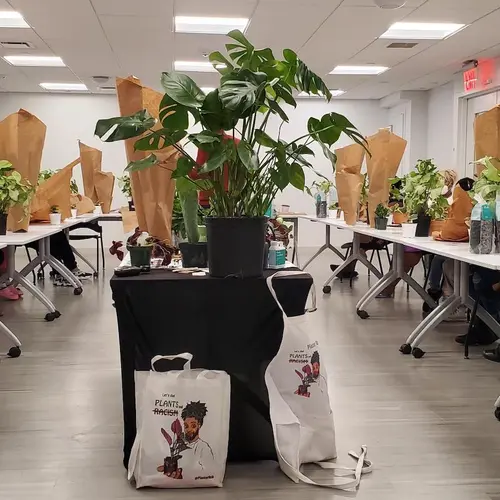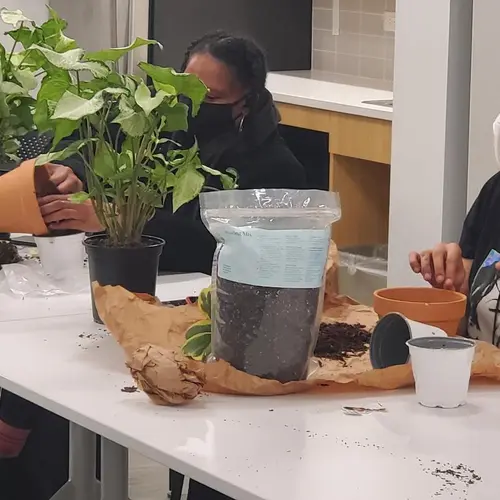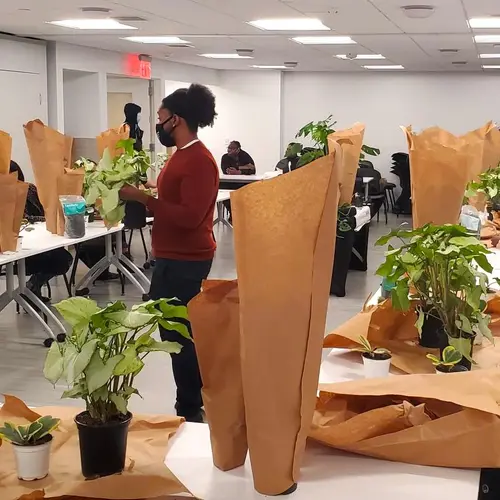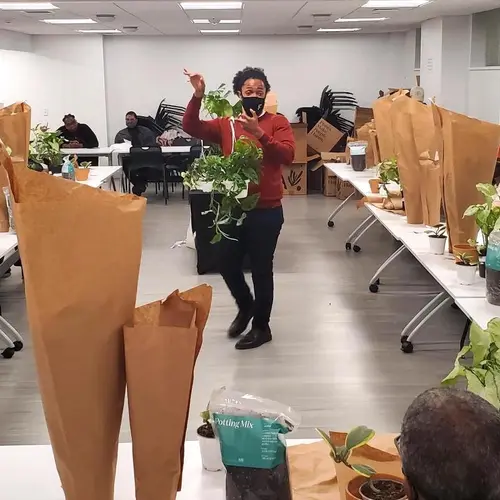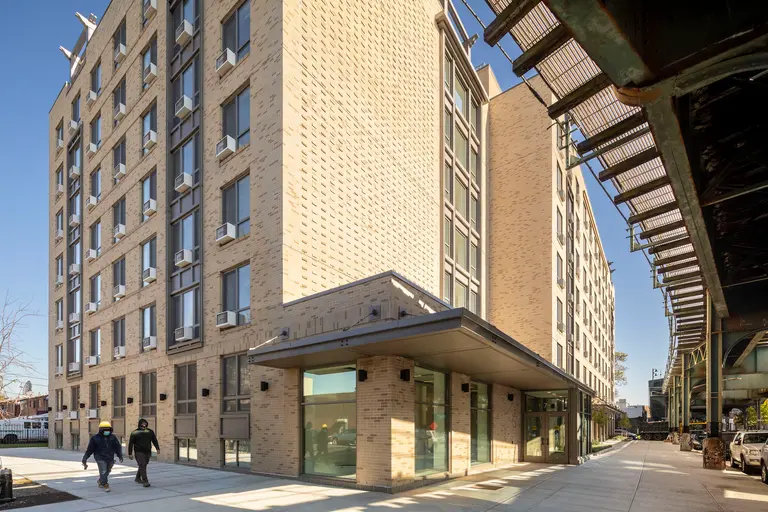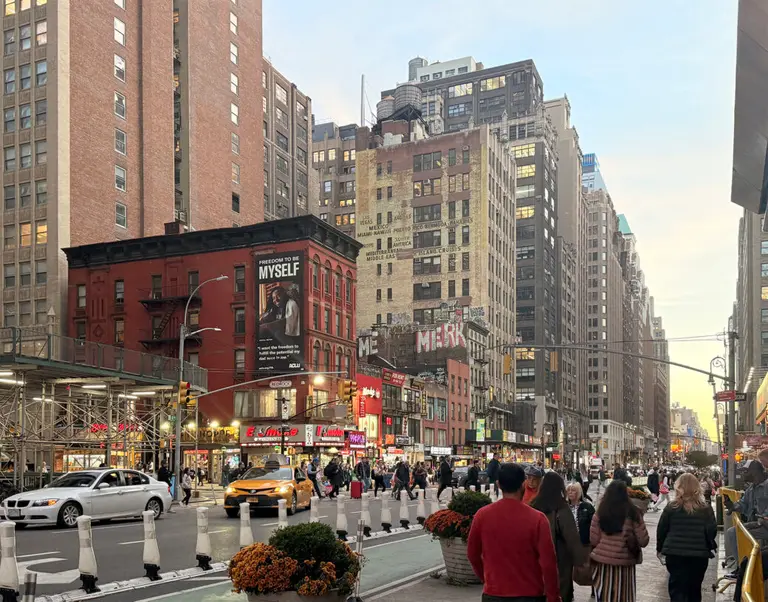How Planter Rob is growing a community of plant lovers & affordable housing advocates in NYC
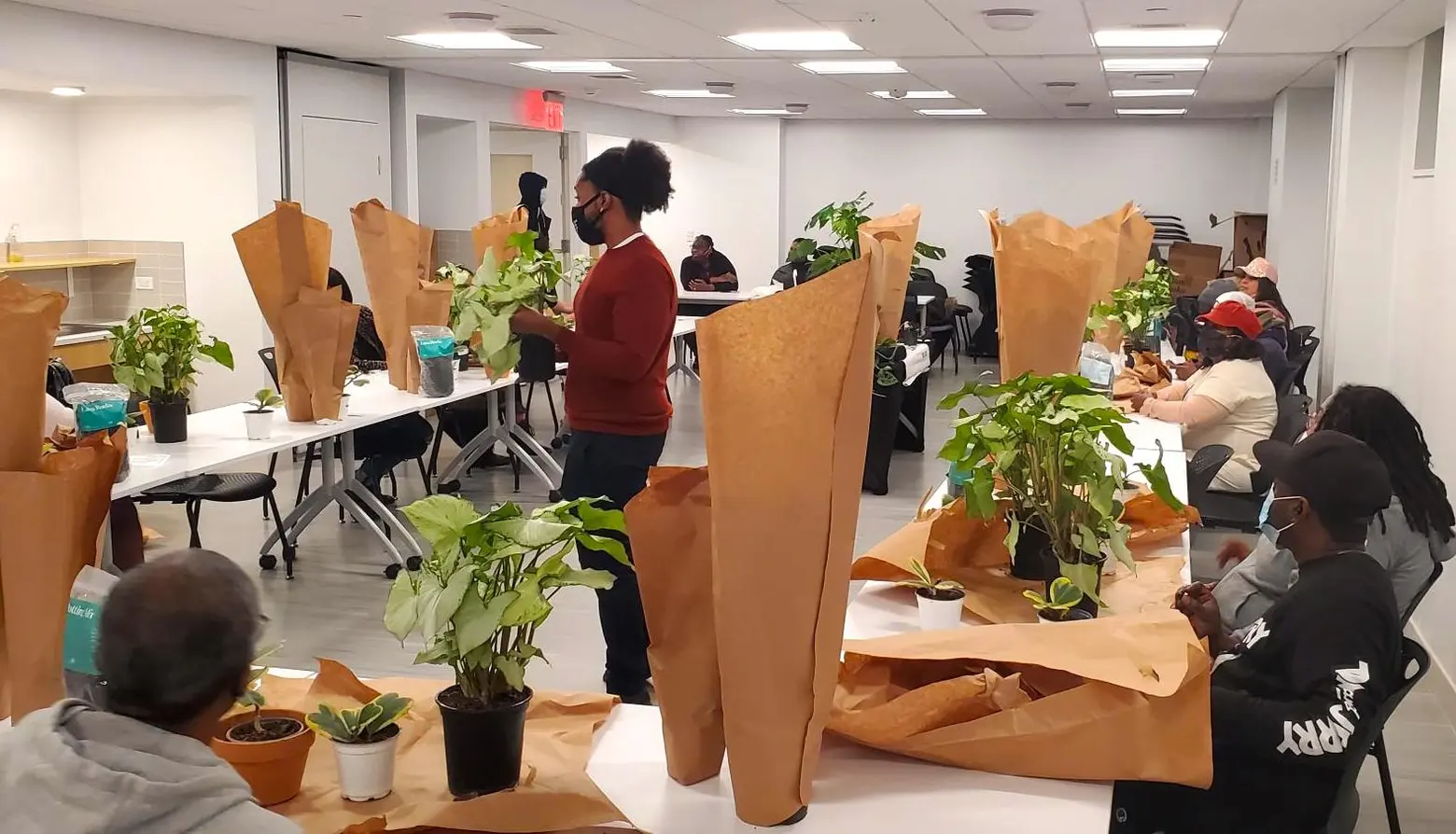
All images courtesy of Breaking Ground
Plant entrepreneur Robert Jeffery, aka Planter Rob, recently teamed up with New York’s largest supportive housing provider Breaking Ground and plant company The Sill to donate nearly 200 houseplants to residents of Edwin’s Place, an affordable housing development in Brownsville, Brooklyn. Jeffery has also started his own “Welcome-Home Plants” program; an initiative that aims to cultivate a diverse community of plant lovers who advocate for affordable housing and reap the benefits plant care brings, like a feeling of belonging and accomplishment. As someone who once faced homelessness, Jeffery can speak on the impact plant care had on his life once he was able to have a place for himself. We spoke with Planter Rob on what influenced him to become involved with houseplants, important issues in the plant community, and how he began his work with Breaking Ground and Edwin’s Place.
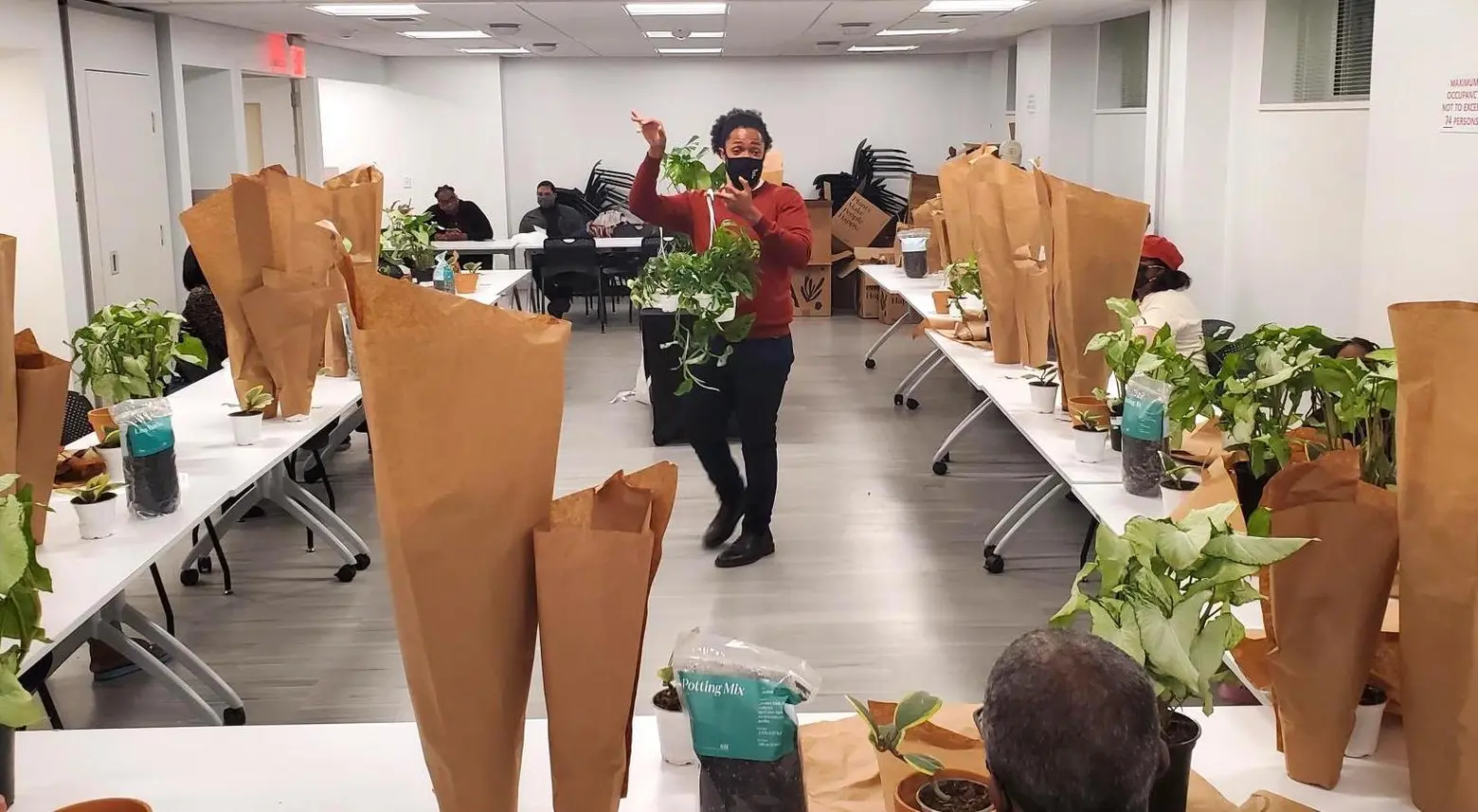
Can you tell me a little bit about yourself and how you got into plant care?
I remember as early as my childhood, my grandmother had a garden in her front yard but at the time I wasn’t old enough to tend to it or the vegetables she had growing. She had cilantro, collard greens, potatoes, all types of vegetables. From that point on, I was always curious about plants and growing things. I never had the opportunity to really indulge in plants until I had my own space and moved to New York City and could finally afford my own apartment where I could get crazy and creative with my own planting. Ever since then, right before the pandemic took off, I started sharing my passion for plants online and found this wonderful, amazing plant community with people from various backgrounds and I realized there weren’t a lot of people that looked like me that were being advertised, sold, or marketed plants, and I kind of took on the voice of the marginalized community in the plant community. That being people who looked like me; Black, gay, queer men that enjoyed plants.
There was a marketing campaign by one of the big plant companies that didn’t include people that looked like me, and the community called it out and we were completely ignored and silenced. From that moment on, I decided I wanted to do more with plants other than just share how I loved what they do for me, such as plant therapy, such as teaching you how to nurture and care for things.
I decided to take plants and really use them as a voice to speak up for marginalized communities. Here I am today, very fortunate to be able to give back to communities that are marginalized like lower-income communities. People that have hobbies with planting tend to have disposable income and with that, those in my community with lower income don’t have the opportunity to indulge in the hobby that I love and I really want to share that. I think that everyone should have the opportunity to join the plant community and that’s why I started my Welcome-Home Plants program because I wanted to give back in a way that makes them feel fulfilled and lets me explore my planting. I’m very fortunate to be able to do this.
How many houseplants do you currently have, and do you have a favorite? Are there any plants you want to grow but have never gotten a chance to?
In my personal collection, I currently have over 80 plants. I also sell plants, so I have a few more here that I have for my online shop. My favorite plant is right here in the corner, it’s a Hawaiian cotton firn. It needs a lot of water and a lot of light, and that’s why I have it right next to my grow light here. It’s one of my favorites because it gives off this sweet aroma of fresh laundry. It’s the favorite of my collection but it’s also my greatest headache.
Plants that I would love to have in my collection would definitely be an albino monstera or a Thai constellation monstera, that’s a monstera that has colors of creme and white in the leaves pattern, and it’s just gorgeous and something that’s really sought after. Since it’s a monstera it’s low maintenance and something that I definitely would love to have in my collection. But, it’s considered a rare plant and growers price it very high so it’s out of my reach right now. They can easily range from $1,500 to $2,000.
Now that it’s springtime, I’m getting back into growing fresh herbs and vegetables, so I also have some seedlings starting over here under my grow light. I’m looking forward to growing shishito peppers over the summer. I did it two summers ago and it was really successful but last year I wasn’t able to do it. I actually grew pumpkins last year which was a lot of fun. We still have some in the freezer here.
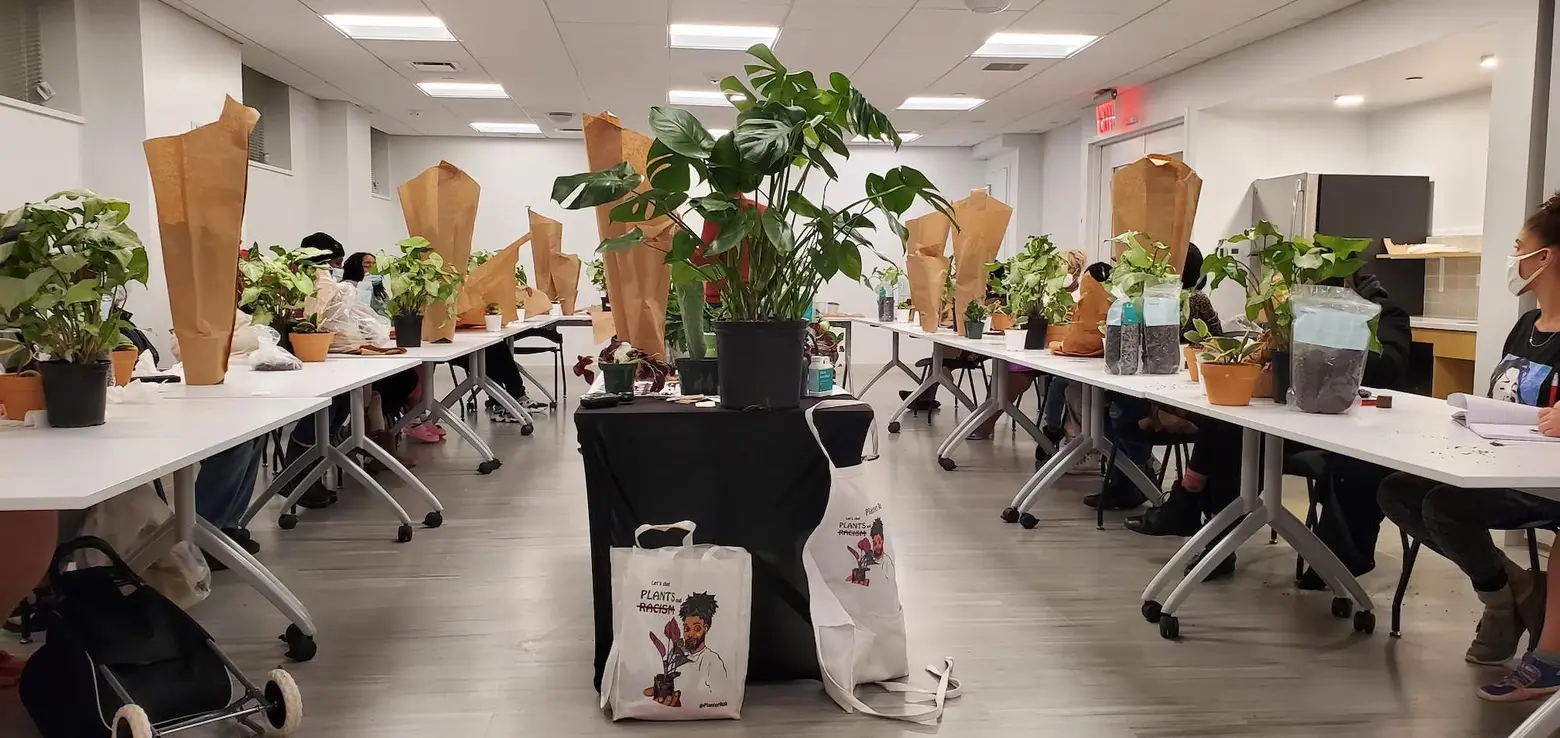
Have you noticed any impact on the number of plants you’ve been distributing, selling, or giving away since the start of the pandemic?
Yeah definitely, I started my Instagram page Planter Rob a year before the pandemic took off and I realized then that there weren’t many people that looked like me or were actively involved in sharing their passion for plants on social media. Once the pandemic took off and people were confined to their homes, a lot of people wanted to bring nature inside and I loved it. By that time I was already a plant influencer, so I was already doing business with people asking me to source different plants for them or to come over and repot personal plants in their collection, or even just selling plants to their businesses.
Once the pandemic started, business took off as well, and I noticed that a lot more people were just bringing nature inside to just have something to care for and nurture, or just something to give them a sense of waking up and a purpose. Now that things are slowly starting to open back up, I am noticing that a lot more people are going outside and aren’t purchasing plants but more people are still investing in plant care and plant therapy. I had a few customers who when I first started my business were buying plants from me like crazy, and now they’re reaching out to me because they want help on nurturing and keeping their plants alive versus bringing in new plants. With that, I’m noticing a lot of people are turning to plants to ground them.
I kicked off my Welcome-Home Plants program with Breaking Ground at Edwin’s Place a few weeks ago and it was so humbling to have complete strangers come to me knowing that I’m offering plants and they would go to their apartments and bring me a plant down and have me look at it, and it was just an emotional time because the connection we all have with plants is universal. It’s something that crosses all boundaries. To have someone tell me or share their story with me about how they lost their job, or they were evicted, and now that they’re back with Breaking Ground and finally have an apartment they are just ecstatic to share with me that they’re finally able to start their plant parenthood journey again and it was truly humbling. Right now in my business, I’m not as interested in just selling plants, I want to sell the experience of having a plant. I want to sell what plants have done for me. They’ve been really grounding for me. I’ve been able to turn to my plants and find a sense of purpose and also find the community that I’ve been embraced by, it’s so amazing and diverse.
I go to Washington D.C., I go to Los Angeles, I go to Chicago, and I can always find a plant person who I can relate to that’s going to take me plant shopping, or have a drink and go to dinner with me. The plant community in itself is so nurturing and embracing, and I really want to be able to give that back to those who are or were experiencing housing insecurity.
For me, I want to take on housing insecurity and affordable housing in particular because once I graduated college I was homeless, I had no idea where I was going to go. I was a first-generation college student and I had no job lined up, there was no money waiting for me after I graduated. I had to figure it out, I was couch hopping with different friends. I remember when I had my dorm room, I was the plant guy. I had a pothos, and I would share it with my bros on the fourth floor and once I finished college I lost that pothos because I had nowhere to care for it.
I was really able to relate with a lot of the residents over at Edwin’s Place. That’s really why I’m fortunate to be able to intersect my passion for houseplants and raising a community of advocates for affordable housing. For me, I’ve always wanted to do more with my plants and I feel like the alignment is happening right now and I’m really thankful for that.
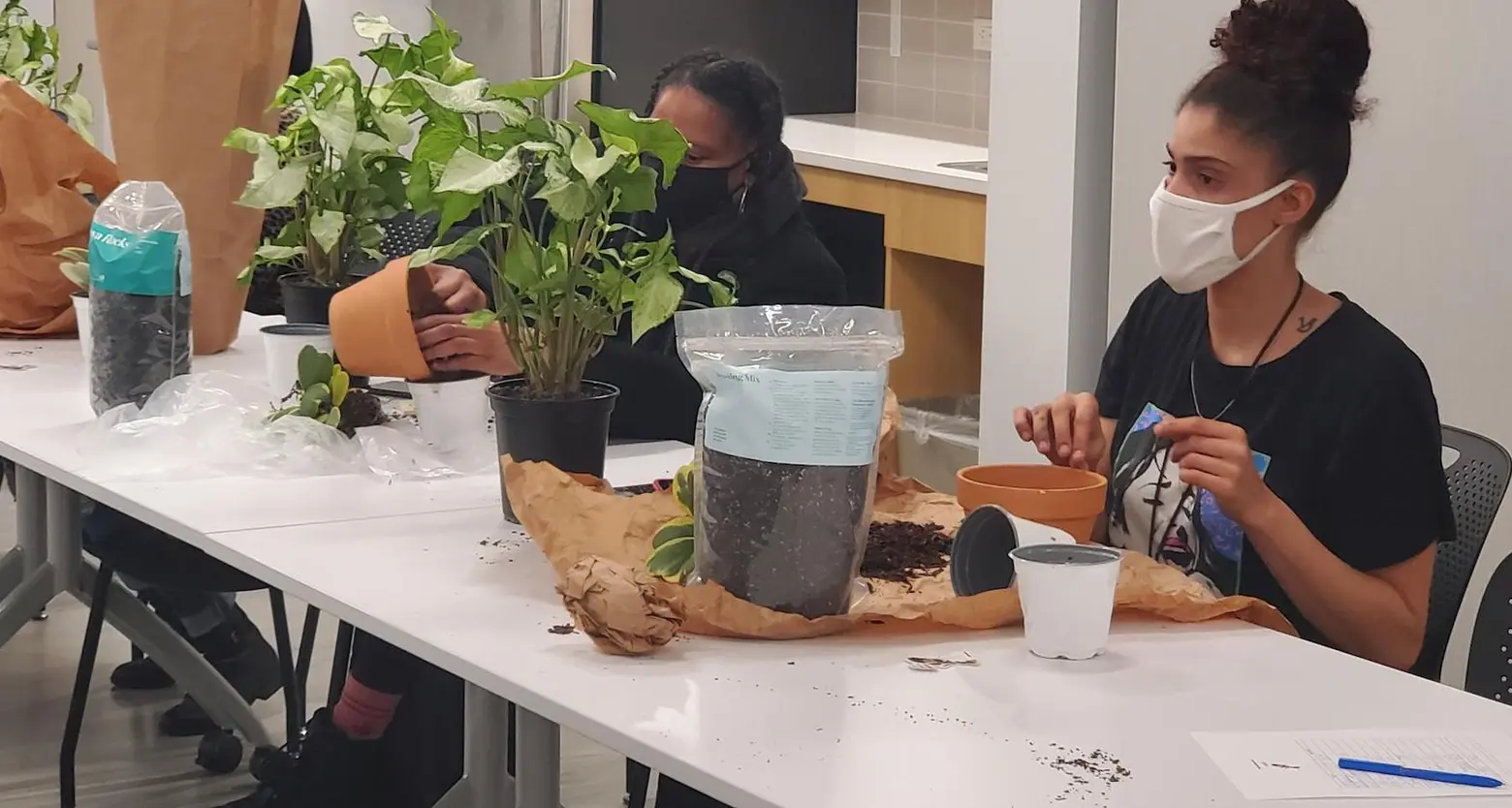
What is the connection between racial inequality and caring for houseplants?
That question can be dissected in so many ways. When we think about plant care, when I think about just being a business owner, the amount of effort it takes to just get a plant from a greenhouse to your front door, there are so many hands that touch it and are involved. When it comes particularly to indoor plants, a lot of times I’ve visited nurseries and greenhouses where I’m getting tours from the higher-ups or the business owners and they tend to not look like me. They tend to be white straight men, and when they show me the greenhouses and who is actually doing the caring for the plants they tend to be people who look like me. They tend to be people who are also in lower-income brackets and that’s gotta stop. That should not be the case.
We definitely need more representation at the top as well as at the bottom. There’s no shame in caring for plants, there’s no shame in being passionate about growing and farming. I think with our society today and the way we’ve treated migrant workers to do the groundwork of growing the plant, and then once we get it to an e-commerce shop the prices of the plant have flipped 10 or 15 times more, the people who are actually growing the plant can no longer afford to enjoy it. That’s just one angle of planting that I want to disrupt. Another thing is if you look at the farmers in the rural south, there are so many Black farmers who’ve lost their land just due to policy or who knows what, and that’s also being overshadowed and overlooked and I want to raise awareness for that as well. As far as me, the initial reason why I got into speaking for my community is that I would share my passion online and realized that these plant companies, I don’t want to name any names, but they weren’t necessarily trying to market towards me or trying to elevate me and my voice or people who looked like me.
During the summer of 2020 with the George Floyd protests, there was a huge uprising of wokeness that took place and that was not happening in the plant community. I really made it my duty to make sure that people in the plant community were also speaking out against racial injustices, speaking out against inequalities, and not just being complacent with others doing the speaking for them. People in the plant community are nice and caring, but they tend to shy away from having a tough conversation. I want to make it easier and less taboo to have those conversations. That’s how my platform took off. My quote is, ‘let’s chat plants and racism,’ because a lot of people tend to just want to talk about plants when I as a Black man cannot just focus on plants, I have to wake up every day and realize I’m living in a society that was built against me.
With that, I want to raise awareness that if I have to address racial inequalities on a daily basis, you should have to do it as well. Whether you look like me, or whether you’re an ally, we need to be having these conversations to dismantle the systemic racism that’s happening in our society right now. I have honestly seen some change, I’ve seen more and more people that look like me share their passion for plants, I’ve been reached out by companies to have discussions on what they can be doing better. I’ve seen companies do some rearranging at the top to make it look more reflective of the market they’re trying to sell to, which has been great. The impact I’m having is really something I can’t put into words because it’s something that’s not tangible. But the change is definitely happening.
It must be great for you to be able to see firsthand the results of your advocacy.
Yeah, and when people reach out to me expressing the changes they’ve made, I’m just elated. It’s all because of plants that I’ve been able to create this change and that’s just mindblowing to me.
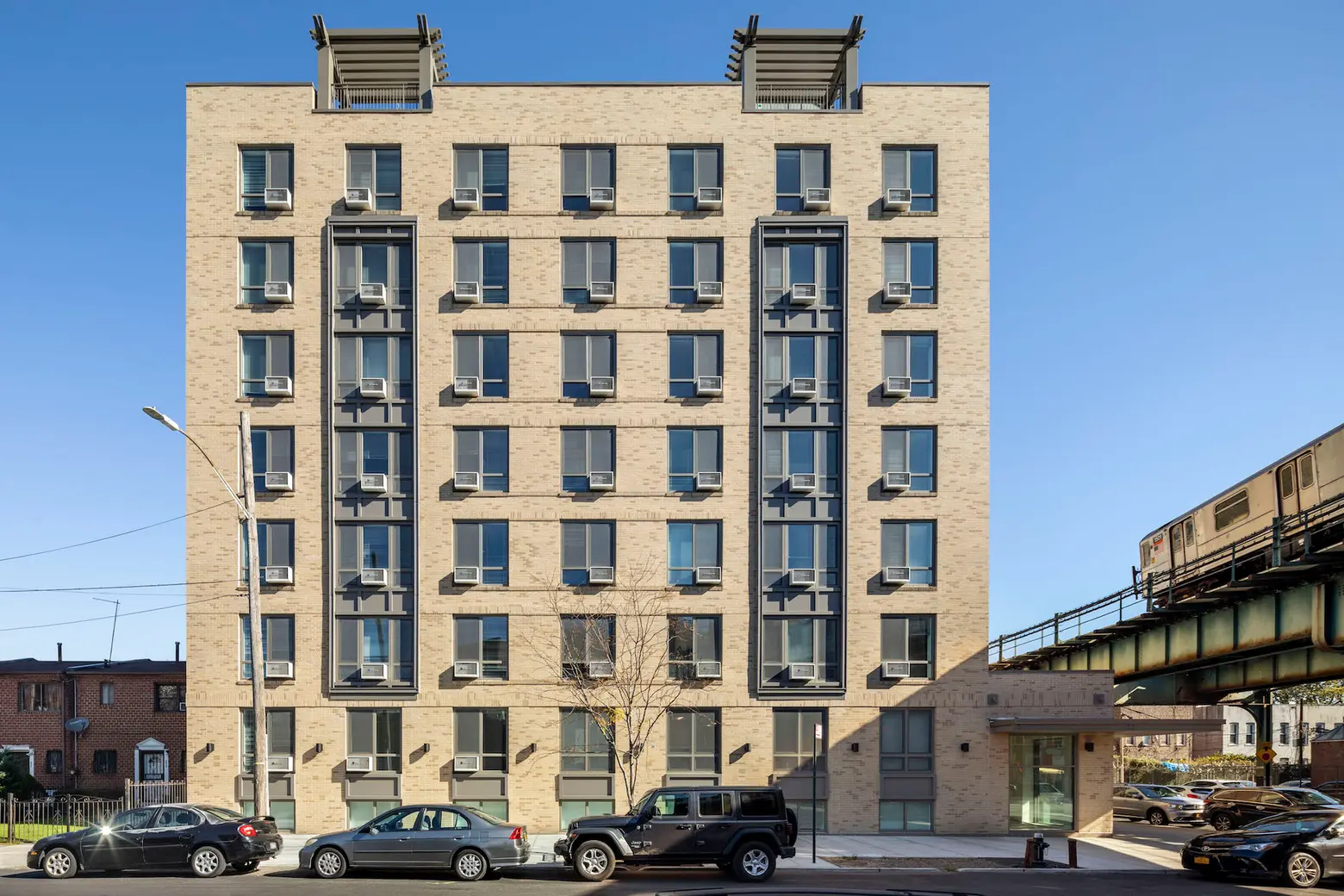
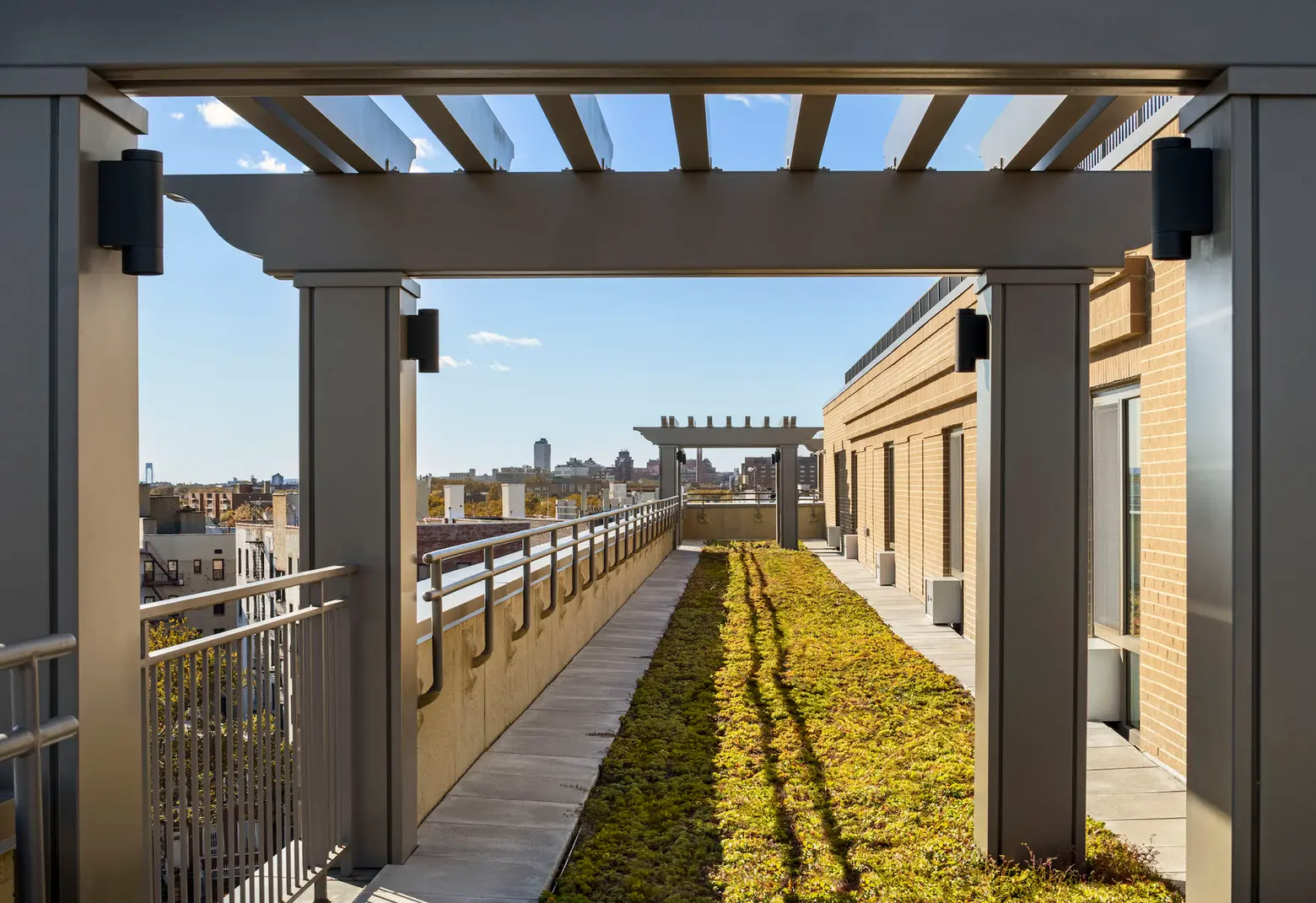 Photos of Edwin’s Place, designed by Robert A.M. Stern © Francis Dzikowski/OTTO
Photos of Edwin’s Place, designed by Robert A.M. Stern © Francis Dzikowski/OTTO
In what ways can houseplants benefit someone who was formerly homeless?
For me, I didn’t feel like I was in my own space until I could bring in a plant. When I did my kickoff with Breaking Ground at Edwin’s Place, it was so humbling to have people share their stories with me about how they had this plant that reminded them of their grandmother or sister or just took them back mentally to a place when things were good. They were trying to get back to that place. Having a houseplant and something to care for and watch grow gives a sense of you’ve made it, a sense of welcome home, a sense of accomplishment, and being grounded. I’ve witnessed that firsthand at Edwin’s Place when we were giving people plants. I could just see it in their eyes and in the words of the stories they shared with me that this was going to uplift them and their space and give them a sense of ‘I’m on the right track.’ That’s exactly what I felt when I first moved to New York City and brought in a plant to my bedroom. I had a sense of, ‘I’m going up from here,’ there is only growth from here. For those that are experiencing housing insecurity that I’ve gifted a plant, I’m hoping they are going to experience that same feeling of growth, the same feeling of moving forward in their life.
With having that plant, you’re going to be embraced by a plant community that is so nurturing and so caring, and I want them to be able to experience that. The main goal here is to create a community and referring back to my Welcome-Home Plants program, just seeing the different residents come to me and get a plant, and seeing another resident come and get a plant and then you have two residents that might not have ever talked or crossed paths at all, but now they have this mutual bond of having a plant to care for. That is the goal, to create a community of plant lovers and embrace them.
What influenced you to start donating houseplants to communities in need like Edwin’s Place?
I just think back to how inaccessible plants have become because of just how expensive this hobby can get. I wanted to make it accessible to everyone and make them feel like they are part of the community that cares, hears, listens, and sees them. I have experienced homelessness, and that’s why I’m on this path myself of wanting to be a voice for those experiencing homelessness or going through housing insecurities. I chose Edwin’s Place because I used to rent out a bedroom over there and I know the neighborhood.
Honestly, it was just a no-brainer for me to go with Edwin’s Place. I live in Williamsburg now and I found Breaking Ground when I was walking around and saw their outreach vehicles that picking up people from the streets and bringing them inside. Once I did a little research on Breaking Ground, I knew this was the nonprofit I wanted to work and align myself with. I was thankful that they have a location in the neighborhood that I used to live in, and that’s the main reason I went with Edwin’s Place.
What are some ways plant owners and people advocate for affordable housing?
I don’t think you need to have any plants to be an advocate for affordable housing. If you are someone in a house, you should be advocating for affordable housing, and if you are someone who happens to love houseplants, you should also be advocating for affordable housing. I have recently joined a nonprofit advocacy group called Open New York and they advocate for affordable housing for all. A lot of people have an image of affordable housing as projects, shantytowns, or run-down buildings, and that’s not necessarily the case. Affordable housing can look very nice, it should look very nice, it should come with accommodations.
I would advocate for joining your local housing groups and look for different advocacy groups. Also, you can follow me as I grow my page and learn more about affordable housing. The language can sometimes get mixed up, for example whenever I would see a new apartment building in a lower-income community or one that I know is filled with mostly people of color, I would automatically jump to, ‘that’s gentrification,’ and think that they’re moving people in and pushing people out. That’s not always the case. I’m learning that gentrification looks like many things. A new building in a lower-income neighborhood could be a great thing. It means that the city is investing in affordable housing and the community. I think it also comes down to getting involved in your local elections and learning the zonings of your boroughs. Also, getting involved in your city boards and learning more information about how you can change the way your city looks.
Do you have any future projects you’re working on that will help advocate for affordable housing and homelessness that incorporates plant care?
The main goal of the Welcome-Home Plants program that I’m doing at Edwin’s Place is to build a community of houseplant lovers that advocate for affordable housing. I don’t want to just stop with Edwin’s Place, that’s just one of many buildings Breaking Ground has, they have over 4,000 units in the city of New York and I want to advocate that everyone in those 4,000 units receive a houseplant.
With that, I want to be able to put this program in motion in different buildings. The overall theme for my program is to grow a community of plant lovers within the permanent housing units with Breaking Ground by giving away free plants. Everyone loves free plants. I really want to have the resources to be able to do that. And two, I really want to build a community. I don’t want to just drop off plants and leave, that’s not my goal here. I want to make connections with residents and residents to make connections with me and other people in the plant community. I want them to have an outlet or resource, or someone they can talk to about their plants.
That’s why also with the program, I don’t just give away plants, but I also host a workshop in which everyone comes together and we’re able to meet and talk face-to-face and build relationships. I would love to be able to grow this program and put this initiative in place in different cities with different nonprofits that are building units for those that need affordable housing. I’m really hopeful that I can grow a community that is resourceful and can help me accomplish that.
RELATED:
- Robert A.M. Stern’s affordable housing building Edwin’s Place opens in Brownsville
- The 10 best plants for apartment dwellers
- The 10 best plant shops in NYC
This interview has been edited and condensed for clarity.
